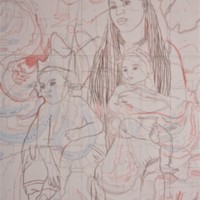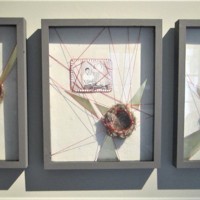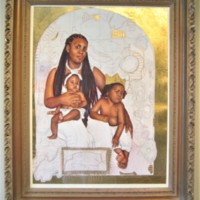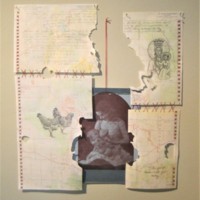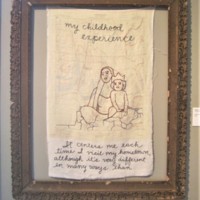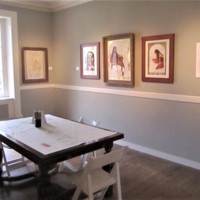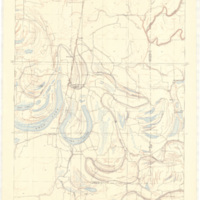Madeline Martin
Using topographical maps from the UWM Libraries’ American Geographical Society Library, Madeline Martin explores familial and ancestral connections to place. In a watercolor and gold-leaf triptych, Martin’s colleague, Tanekeya Word and her children personalize the symbol of family. These portraits, illustrating intergenerational reciprocity, were created by patient applications of watercolor paint. The changes on the paper were slow and gradual, until eventually their figures emerged.
Word’s toddler son wears a crown, a nod to his preciousness and his inherited traits. The crown also legitimizes his sovereignty over his own unfolding life. Word nurses her infant daughter in one image, their bond physical and ancient. In another of the triptych images, the infant daughter looks directly at the viewer. She is pure potential. Her cells have been formed by the whispers of ancestors who have come before her, while her life embodies renewal and trust in her caregivers, particularly her mother.
Word and her children are surrounded by the lines of topography near two small towns in Mississippi: Friars Point and Jonestown, the land of Word’s birth, and the land that raised up her parents and grandparents. The rhythm of topography was not applied in a cartographic exactness, for it suggests the subtle ambiguity and fluidity of memory. The cellular memory of our ancestors runs through our veins, connecting us to the land from which they have flown.
In another piece, Martin uses a topographical map of her own childhood home, a rural Wisconsin area in the town of Forest. Drawings of the chickens she raised in childhood, the Virgin Mary, and a journal entry about her own mother cross the map’s lines. These cartographic demarcations outline a physical place without revealing the lives or stories nestled among its topography, so Martin personalized this map by suggesting it is a place that developed her own empathy and desire to eventually become a mother.
Martin utilizes embroidery, gold leaf, drawing, beeswax, and watercolor paint for their functionality and also for their conceptual relevance. Embroidery signifies intergenerational threads of connection; gold leaf signifies the precious and sacred; beeswax preserves while it also suggests skin; watercolor is fluid, transparent, and glows from committed devotion.
